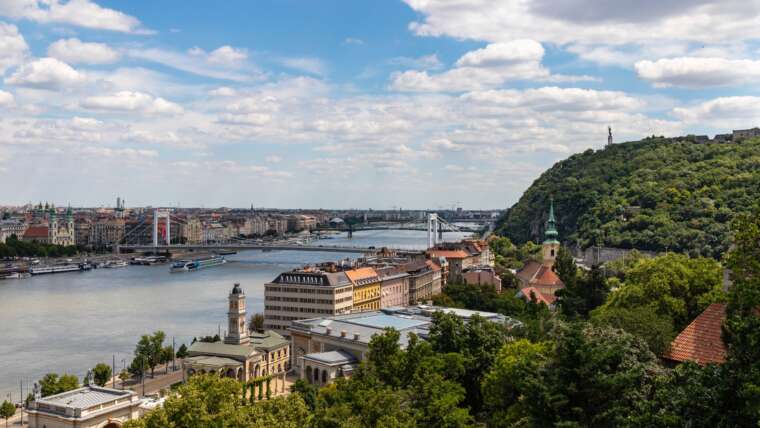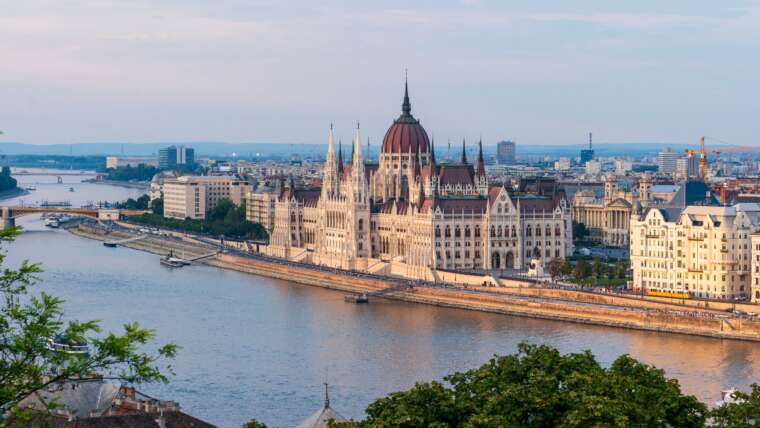Hungary is a landlocked country in Central Europe. Its capital, Budapest, is bisected by the Danube River. Its cityscape is studded with architectural landmarks from Buda’s medieval Castle Hill and grand neoclassical buildings along Pest’s Andrássy Avenue to the 19th-century Chain Bridge. Turkish and Roman influence on Hungarian culture includes the popularity of mineral spas, including at thermal Lake Hévíz.
Day 01: Arrive in Budapest
In and around Budapest
Arrive Budapest Meet and assist at thee airport and transfer to hotel. Hungary is a land of beautiful monuments and romantic music. Buda and Pest, two of the city’s three regions, both face the mighty Danube, which forms the physical and spiritual centre of the Hungarian capital. It is its centrepiece, its heart, and its pulse. Its relationship with the city is even more intimate than that of the Seine with Paris or the Arno with Florence.
Overnight in Budapest.
Day 02: Budapest
This morning we depart for a bus tour of Budapest. Start our day at Heroes Square and near by Vajdahunyad Castle, where we briefly learn a bit about the history of Hungary. Our tour will continue toward Margaret Bridge over which we cross to the Buda side. Our next stop is the Citadel, a great place for panoramic views of the whole city. After a quick picture stop we continue to castle hill where we spend the rest of the day. A visit of St Matthias Church and the Fisherman’s Bastions is by many seen as a highlight of the day.
After a lunch break we continue on foot to the Royal Palace, where we visit the National Gallery, dedicated exclusively to Hungarian art.At this point you are free to continue independent exploration or return on our bus back to the hotel.
Overnight in Budapest.
Day 03: Budapest Walking Tour
This morning we embark on a leisurely WALKING tour of city’s urban heart. This is an area full of stately old buildings, grand avenues, and innumerable tiny streets. We will take local transport to the huge neo-Gothic Parliament (Orszaghaz), the most visible building of Budapest’s left bank. Built by 1,000 workers between 1885 and 1902, this building has now become the symbol of the capital with its slender towers, spacious arcades, high windows and vast central dome. Nearby one can see the magnificent building housing the Museum of Ethnography. Walking southeast we come to the stately and sprawling Liberty Square (Szabadsag ter). In the square’s center remains a gold hammer and sickle atop a white stone obelisk, one of the few monuments to the Russian ‘liberation’ of Budapest in 1945. Passing by Roosevelt Square we soon come to the famous Chain Bridge, the oldest and most beautiful of the seven road bridges that span the Danube in Budapest. Before it was built, the river could be crossed only by ferry or by a pontoon bridge that had to be moved when ice blocks began floating downstream in the winter.
We continue along the pedestrian ‘Promenade’ with great views of Gellert Hill and Castle Hill on the opposite bank. We will stroll past the Concert Hall (Vigado), which is a curious mix of Byzantine, Moorish, Romanesque and Hungarian motifs. From here we walk to one of the liveliest places in Budapest, Vorosmarty Ter, a large square that the north end of Budapest’s best known shopping street–Vaci Utca. This is a fantastic pedestrian-only area of the city that has undergone a full transformation over the last 10 years.Eventually we will arrive at the famous 19th century Central Market Hall. This cavernous three-story market teems with people browsing stalls packed with everything from salamis and red-paprika chains to folk embroideries and souvenirs. The balance of the day at leisure.
Overnight in Budapest.
Day 04: Budapest – Szentendre – Holloko – Eger
In and around Eger, Szentendre, Holloko
This morning we travel by private coach to the riverside town of Szentendre, along the ‘Danube Bend’. Szentendre is known for its museums, galleries and artists. Populated for well over a millennium, under the Romans it was called Ulcisia Castra, meaning Wolf Castle. Today its south European atmosphere with baroque architecture, churches of various faiths, narrow side streets, and cobblestone roads characterizes this town. You tour leader will take you on a walking tour through this gorgeous little town. From Szentendre we continue on towards Eger.
We will make a stop in the UNESCO protected village of Holloko, a small town of approximately 650 people. What sets this village apart from others is the ‘Old Village’ where 50 houses have been listed and declared historic monuments. Throughout time Holloko has managed to preserve its unique ethnographic and folk art values. The village itself is picturesque, with its cobbled streets and little white houses. Atop the nearby hill we can view what remains of a 13th century castle that was blown up by the Hapsburgs. From here we continue on to Eger, situated in the Eger Valley between the Bukk and Matra Hills.
Eger is famous for Red Bull’s Blood (Egri Bikaver) wine, its medieval library, and for having the northernmost minaret in Europe. There are still many accessible sites and much charm to the narrow streets, arcaded buildings, wrought-iron gates, and Baroque towers and domes of the Old Town. This is the perfect walking city with something interesting at every turn. The nearby peaks of some of Hungary’s highest mountains provide a natural backdrop for this city’s historic monuments.
Overnight in Eger.
Day 05: Eger: Town Tour
Eger has been inhabited since the Stone Age. During the early Middle Ages the area was inhabited by German, Avar and Slavonic tribes. Taken over by the Hungarians in the 10th century, Eger reached an age of prosperity during the 14th-16th centuries. Winegrowing, for which the town is still famous, began to be important at that time. During the Turkish occupation of Central Hungary, Eger became an important border fortress, successfully defended by Hungarian forces in the 1552 Siege of Eger, in the face of overwhelming odds.Our walking tour today will include a visit to the famous castle of Eger with its museum and underground casements. We will also see the Archbishop’s Palace, Franciscan Church, and Turkish Minaret.
Overnight in Eger.
Day 06: Eger – Paks – Siklos – Pecs
Today we depart early for our journey from Eger to the region of Southern Transdanubia, a region of undulating hills, forest clad ridges and rural ambience. After passing Budapest we start our route south, traveling parallel to the Danube River for much of our journey. After passing by Paks, a town in central Hungary on the banks of the Danube River, we will continue to the city of Pecs. Pecs has been selected to be the European Capital of Culture in 2010, sharing the title together with Essen and Istanbul. This is a city not to be missed; as it is a major art center and university town. Here we will take a walking tour of the Old Town, and will see the historic cathedral, synagogue, mosques and fourth-century Christian necropolis, a UNESCO World Heritage Site with burial chambers decorated in murals.
Overnight in Pecs.
Day 07: Pecs – Villany – Pecs
This morning we will venture towards the southern border to visit the historic town of Siklos and its well-preserved medieval castle. Wine has been produced in this region since the Romans settled here at a place they called Seres. After our visit to the castle we will break for lunch before an afternoon of sightseeing, starting with the the famous Villany-Siklos Wine Road, 30 km long and covering eight villages. The Romans finds uncovered at the base of the hills prove that people have been growing grapes and making wine here for over 2,000 years. Today the Villany-Siklos wine region covers an area of about 2000 hectares. We return to Pecs for our overnight.
Overnight in Pecs.
Day 08: Pecs – Lake Balaton Region – Budapest
Today we proceed north to the Lake Balaton Region. Lake Balaton is the largest lake in Central Europe and is often affectionately called the “Hungarian Sea”. Our day will be spent exploring this region. We will cross the lake by ferry from Szantod to Tihany. The Tihany Peninsula was declared a national park in 1952, and the peninsula is well known for its historical monuments, beautiful panorama and its Mediterranean climate.
Balatonfured is a small town on the northern shore of the lake and is part of a region that was important to social life in the 18th century, even before bathing and swimming took off as a mass pastime 100 years later. This is the place where the first Balaton steamship started its trips, and the first yachtsmen’s association began here. Here were built the villas of 19th-century celebrities, and the town is still the center of festivities. Patients have been treated here for three hundred years with the help of the mineral water sources, as the water is good for diabetes and digestive malfunctions. Veszprem is a quaint and quiet town away from the lakeshore region, and here we will take a walk in the Castle Quarter. At the end of our day we travel back to Budapest for our last night in Hungary.
Overnight in Budapest.
Day 09: Depart Budapest
After breakfast Departure transfer to Airport to catch the flight for Onward Journey.
| Place | Night (s) | Hotels |
| Budapest | 03 | Budapest Marriott Hotel |
| Eger | 02 | Imola Hotel Platán |
| Pecs | 02 | Corso Hotel in Pécs |
| Budapest | 01 | Budapest Marriott Hotel |
- Welcome on arrival with fresh flower garlands.
- Meet to attend airports / hotels by our office representative.
- 08 nights in accommodation as per the program.
- Meals as per Program
- Guide Services ( English language )
- Entrance fees to the monuments.
- All taxes.
• International flights
• Personal Expenses.
• Camera / Video Camera Fees.
• Medical Aid.
• Tipping.
• Travel Insurance.
• Visa If any.
• Accommodation in good hotels.
• Check-in / out time is 12 noon at most of the hotels.
• Extension to other places is also possible with a minimal extra cost. – Additional nights are available at each place with minimal supplement.
• A visa is required and must be obtained prior to your departure from your Country.
• If quoted hotel is not available, we will provide one of a similar category and standard.
• Small deviations in the tour program are sometimes necessary, depending on weather, road conditions, flight schedules and room availability.
• In case the government changes presently applicable taxes, increase in airlines prices, fuel surcharge our rates will need to be adjusted accordingly.
• In Asia, there is no relevance between the distance and time of travelling, as it depends upon the condition of the roads and congestion of the traffic.
• While every effort will be made to maintain the itinerary, in view of local strikes etc that are beyond our control all schedule and itineraries are subject to last moment changes.
• Clients must be fully insured, as the company cannot accept liability for loss or damage to client’s property, medical emergencies or any other loss suffered by them whilst on tour.
• In Case of issuing Domestic or International air tickets, SGV is not responsible for any refund if the flight is delayed or cancelled, as it is the responsibility of airline.





